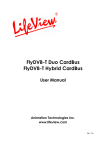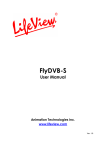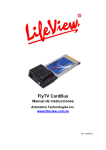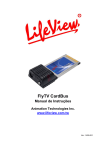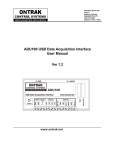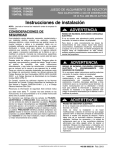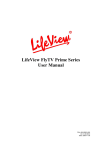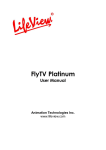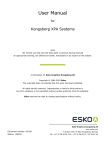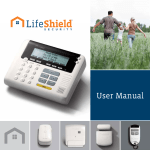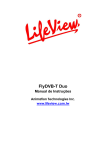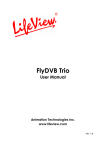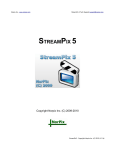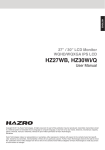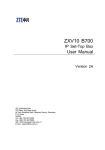Download FlyTV Express M5 MST-T2A2 User Manual
Transcript
FlyTV Express M5 MST-T2A2 User Manual Animation Technologies Inc. www.lifeview.com Ver: 1.0 Copyright and Trademark Notice ©2006 by Animation Technologies Inc. All rights reserved. Information in this document is subject to change without notice. No part of this document may be reproduced or transmitted in any form or by any means, electronic or mechanical without prior written permission of Animation Technologies Inc. Animation Technologies Inc. makes no representation or warranties with respect to the contents hereof and specifically disclaims any implied warranties of merchantability or fitness for any particular purpose. Animation Technologies Inc. reserves the right to revise this manual and to make changes in its content without obligation to notify any person or organization of such revision or change. In no event shall Animation Technologies Inc. be liable to you or any third party for any consequential, incidental, direct, indirect, special, punitive, or other damages (including without limitation, damages for loss of profits, interruptions, loss of information, pecuniary loss, etc.), even if Animation Technologies Inc. has been advised of the possibility of such damages arising from any defect or error in this manual or product. Updates to this documentation can be obtained from our website: http://www.lifeview.com. Windows® is a trademark of Microsoft Corporation. All other brand names used in this document are registered trademarks of their respective companies. CE Statement: This equipment has been tested and complies with EN 55013: 2001+A1:2003, EN 55020: 2002+A1: 2003 (S1, S2a, S2b, S3, S4), IEC 61000-4-2: 2001, IEC 61000-4-3: 2002+A1:2002, IEC 61000-4-4: 2004, EN 55022: 1998+A1: 2000+A2: 2003, Class B, EN 55024: 1998+A1:2001+A2: 2003, IEC 61000-4-2: 2001, IEC 61000-4-3: 2002: +A12002, IEC 61000-4-4: 2004, IEC61000-4-5:2001, IEC 61000-4-6: 2003+A1:2004, IEC 61000-4-8: 2001, IEC 61000-4-11: 2004 standards. Contents 1. Getting Started ................................................................. 1 1.1 Introduction................................................................................................... 1 1.2 Features ....................................................................................................... 1 1.3 Package Contents ........................................................................................ 2 1.4 System Requirements .................................................................................. 2 2. Input & Output Connections ........................................... 3 2.1 FlyTV Express M5 MST-T2A2 Connections................................................... 3 3. Installation ........................................................................ 5 3.1 DirectX.......................................................................................................... 5 3.2 Installing the FlyTV Express M5 MST-T2A2 .................................................. 6 3.3 Driver Installation for Windows 2000 / Windows XP ..................................... 7 3.4 Installation of LifeView MVP ......................................................................... 8 3.5 Setting up your inputs ................................................................................... 8 4. The LifeView MVP ............................................................ 9 4.1 MVP Interface Overview ............................................................................... 9 4.2 Selecting an input ....................................................................................... 10 4.3 Scanning for TV Channels (DVB-T TV) ...................................................... 10 4.4 Scanning for channels (Analog TV) ............................................................ 12 4.5 Scanning for FM stations (FM Models) ....................................................... 13 4.6 Channel list................................................................................................. 14 4.7 Volume controls .......................................................................................... 14 4.8 Signal Strength Meter ................................................................................. 14 4.9 Audio Stream Select ................................................................................... 15 4.10 Aspect Ratio Select .................................................................................. 15 4.11 Teletext..................................................................................................... 16 4.12 EPG .......................................................................................................... 17 4.13 Keyboard Shortcuts .................................................................................. 18 5. PIP and M-PIC Modes .................................................... 19 5.1 Available combinations ............................................................................... 19 5.2 PIP Mode.................................................................................................... 20 5.3 M-PIC Mode ............................................................................................... 21 6. Recording and TimeShifting ......................................... 22 6.1 The Recording Button................................................................................. 22 6.2 The TimeShift Button .................................................................................. 23 6.3 Schedule Recording ................................................................................... 24 6.4 Snapshots................................................................................................... 25 6.5 Play Mode................................................................................................... 25 7. Settings ........................................................................... 26 7.1 MVP Settings.............................................................................................. 26 7.2 Analog Settings .......................................................................................... 27 8. Technical Support.......................................................... 30 8.1 Contact Us.................................................................................................. 30 Getting Started 1. Getting Started 1.1 Introduction Thank you for choosing the FlyTV Express M5 MST-T2A2 TV tuner and video capture card. This product turns your desktop PC into a powerful multimedia system quickly and easily. Capture video and still images and experience real-time recording. Watch both digital TV and analog TV or video at the same time, on the same screen, thanks to LifeView’s exclusive MST technology! The FlyTV Express M5 MST-T2A2 provides you with a high quality TV viewing experience with true stereo sound! 1.2 Features • • • • • • • • • • • • Dual DVB-T Silicon Tuners Dual Analog TV Silicon Tuners Support for worldwide TV standards S-Video/composite video inputs PIP (Picture in Picture) Real-time recording from Digital TV, Analog TV, and Analog inputs LifeView’s exclusive MST lets you watch both Digital TV and Analog TV/video simultaneously Watch TV in a resizable window or full-screen TimeShifting functions Capture still images Listen to DVB radio Compatible with Windows® 2000 and XP 1 Getting Started 1.3 Package Contents When removing the contents of the package, please inspect all items to ensure no damage was sustained during shipping. The following items should be included in the package: • • • • • • • • • • FlyTV Express M5 MST-T2A2 card PAL connection adapters NTSC connection adapters (optional) A/V-Cable DVB-T Portable Antenna Installation CD-ROM Quick Installation Guide Remote control (optional) FM antenna (FM models only) FM antenna connector (FM models only) Note: The included antenna is only suitable for areas with a strong DVB-T signal. If you have reception problems, first try to move or reorient the antenna. Otherwise, you may need to use a stronger antenna for better reception. 1.4 System Requirements To successfully use the FlyTV Express M5 MST-T2A2 solution, please ensure that your system meets the following requirements: • • • • • • • • • • 2 Pentium® 4 or AMD Athlon 2.0GHz or Pentium M 1.7GHz or faster, 2.4GHz or faster recommended 512 MB RAM or more Microsoft Windows 2000 (SP4) / XP (SP2) or higher 100MB available hard disk space for full software installation, additional space required for recording or TimeShifting CD-ROM or DVD drive VGA chipset with full DirectX 9.0 support DirectX 9.0c or higher installed Available ExpressCard 54 slot TV antenna or cable for digital TV TV antenna or cable for analog TV Input & Output Connections 2. Input & Output Connections 2.1 FlyTV Express M5 MST-T2A2 Connections The FlyTV Express M5 MST-T2A2 card supports digital TV, analog TV, S-Video and composite video input. See the diagram below for connection details. 1 2 3 Connects to the A/V Cable for connecting external devices like VCRs or camcorders 2. RF in 2 Connects to a DVB-T digital antenna or an analog TV antenna/cable 3. RF in 1 Connects to a DVB-T digital antenna or an analog TV antenna/cable FM Models: Connects to FM antenna 1. A/V in: 3 Input & Output Connections 4 5 10 6 7 8 9 4. S-Video [Black]: 5. Audio (R) [Black] 6. Audio (L) [Black]: 7. Composite [White]: 8. Audio (R) [White]: 9. Audio (L) [White]: 10. A/V plug: 4 Connects to an S-Video source Connects to right audio channel for S-Video source Connects to left audio channel for S-Video source Connects to composite video source Connects to right audio channel for composite video Connects to left audio channel for composite video Connects to A/V in port on card Installation 3. Installation The following sections provide step-by-step instructions on installing and configuring the card, accessories and software. 3.1 DirectX Before installing your FlyTV Express M5 MST-T2A2, it is necessary to install DirectX 9.0c or higher. Insert the installation CD and an installation menu should load automatically. If the Autostart program does not appear automatically when you insert your LifeView Installation CD, start it manually by running the InstallCD.exe file located on the LifeView Installation CD, or by clicking the Start button, choosing Run…, and typing in D:\InstallCD.exe. (if D: is your CD-ROM drive) Click on DirectX 9.0 and follow the prompts to install DirectX. After the installation is completed, shut down the computer. 5 Installation 3.2 Installing the FlyTV Express M5 MST-T2A2 Simply slide the card into your notebook’s ExpressCard slot, and make sure it is fully seated. Connect your digital TV antenna and/or your analog TV antenna/cable to the FlyTV Express M5 MST-T2A2‘s RF inputs. You can use a house antenna or the included portable antenna for digital TV reception, and you can use a house antenna, cable TV line, or another source for your analog TV input. If you wish to use the same antenna/cable for both RF inputs (whether it is for digital or analog TV), you will need to use a signal splitter to connect your antenna/cable to the FlyTV Express M5 MST-T2A2. RF1 RF2 6 Installation 3.3 Driver Installation for Windows 2000 / Windows XP Windows 2000 / XP will automatically detect the FlyTV Express M5 MST-T2A2 card and brings up the Found New Hardware Wizard window. If you have not already done so, place the Installation CD into your CD-ROM drive. Select Install from a list or specific location (Advanced) and click Next. Now select Search for the best driver in these locations, make sure “Search removable media is checked, and click Next. Windows will now find the drivers on the Installation CD and install them automatically. After installing the driver, Windows will inform you that it has done so successfully. Click Finish. 7 Installation 3.4 Installation of LifeView MVP Install the LifeView MVP software by clicking on LifeView MVP Setup. Just follow the prompts to install the software. 3.5 Setting up your inputs When loading the MVP for the first time, the Device Configure window will appear. Indicate what source you have connected to each input; select DVB-T for a digital antenna or Analog TV for an analog TV antenna/cable. Note: You cannot have an analog source on RF1 if you are using S-Video, and you cannot have an analog source on RF2 if you are using composite video(AV-In). If you want to watch analog TV with S-Video, connect your Analog TV source to RF2. If you want to watch analog TV with composite video (AV In), connect your Analog TV source to RF1. Also, if you select FM Radio, you cannot have Analog TV on RF2 or any analog inputs selected (S-Video and/or composite video). 8 The LifeView MVP 4. The LifeView MVP 4.1 MVP Interface Overview 1 2 3 4 5 6 11 7 8 9 10 12 13 14 15 16 17 18 19 1. Source select buttons 2. Toggle PIP mode 3. Toggle M-PIC mode 4. Switch to Play Mode 5. Toggle fullscreen/windowed viewing mode 6. Show/hide channel list 7. Open Scan Settings 8. Open Settings 9. Open EPG window 10. Open Teletext (when available) 11. Channel list 12. Rewind 20 21 22 23 24 13. Previous/Next Channel 14. Start Recording 15. TimeShift Start/Pause, Play/Pause 16. Stop Recording/TimeShift/Playback 17. Skip to beginning/end 18. Mute on/off 19. Volume bar 20. Signal Strength Meter 21. Audio Stream Select 22. Aspect Ratio Select 23. Snapshot 24. Fast Forward 9 The LifeView MVP 4.2 Selecting an input The source select buttons will change depending on what you have available. To change the available inputs, use Reconfigure Device Connection from the Settings menu. Switch to DVB-T TV Switch to Analog TV Switch to S-Video Switch to composite video (AV In) Switch to FM Radio (for FM models) 4.3 Scanning for TV Channels (DVB-T TV) Before you can watch digital TV, you have to scan for available channels in your area. On the Menu Bar, click on Tool, then click on Scan. You can also click on the Scan button on the left side of the screen. Receiving Setup: This shows the current reception standards the MVP application is set to. In general, most countries have a bandwidth of 7,8 MHz. Here, you can choose the setting that matches your country. Services Information: This shows information about the currently selected channel when available. During a scan, this will show information on the status of the scan 10 The LifeView MVP Channel Scan: There are two ways to scan for available channels, Auto Scan and Transponder Scan. 1. Auto Scan: Select Auto Scan, then select your country from the drop-down box and click Scan. 2. Transponder Scan: If you want to manually enter a frequency, select Transponder Scan, type in the Frequency in kHz and click Scan. Found channels will be displayed in a window, and here you can customize your channel list. You can sort your channel list by Service Name, Frequency, Network Provider, Transponder ID, and Audio type by clicking on the button at the top of each column. Click on the Service Name of a channel to rename it. Scrolling to the right, you can choose the audio stream to be played by clicking on its Audio type. You can uncheck a channel so it does not appear in your channel list, or you can select it and click Delete to remove the channel entirely. You can also import channel lists into your current list by clicking Import, you can load another channel list by clicking Load, and you can save your channel list by clicking Save As… To save your changes, click OK. To cancel your changes, click Cancel. 11 The LifeView MVP 4.4 Scanning for channels (Analog TV) When in TV mode, choosing Tool then Scan or clicking on the Scan button will open up the following screen. Here, click on the Scan button to automatically scan all channels for availability and remove any unavailable channels. You can also change your Country to set your TV Standard, or you can change your TV Standard directly by using the dropdown boxes. You can change the Input Type to designate whether you use an antenna(Air) or cable TV(Cable). You can edit your channel list by using the checkboxes next to the channel name unchecked channels will be hidden from the channel list. (You will still be able to switch to the channel by typing in the channel number) Click on the name of the channel to edit the name that will appear in your channel list. You can also click on the Audio Format of the channel to choose between MONO or STEREO sound (when available). 12 The LifeView MVP 4.5 Scanning for FM stations (FM Models) When in FM mode, choosing Tool then Scan or clicking on the Scan button will open up the following screen. To begin a full autoscan for radio stations, click the Scan button. The process will take a couple minutes; you can stop the scan by clicking Stop. You can also manually enter a frequency by clicking on Set to tune to that frequency and then clicking on Add to add the frequency to your station list. Clicking on Previous or Next will autoscan to the previous or next station, and the ▲ and ▼ buttons will fine tune the frequencies. You can rename a station by selecting it and clicking on its name. To take stations out of your list, select it and click on Delete. To save your changes, click on Save or OK; to cancel your changes, click on Cancel. 13 The LifeView MVP 4.6 Channel list On the right side of the interface is the channel list. Here you will see available channels for your currently selected source. Simply click on a channel to switch to it, or press the K or L arrow keys to switch channels. Note: If you have S-Video or composite video selected as your source, the channel list will not appear. 4.7 Volume controls At the bottom of the interface is the volume bar. Click on the bar to set the volume to that level, or press the I or J arrow keys to decrease or increase the volume. Click on the speaker icon to mute the audio. 4.8 Signal Strength Meter The signal strength meter indicates how strong the signal is for the current channel. Blue lights indicate good reception, green lights indicate fair reception, and red lights indicate poor reception. Note: This meter is only for digital TV signal strength. 14 Good reception Bad reception The LifeView MVP 4.9 Audio Stream Select Clicking this button will open a dropdown menu that shows all available audio streams. The current audio stream will be marked with a z. Simply click on an audio stream to select it. You can also switch between available audio streams by pressing the A key on the keyboard. 4.10 Aspect Ratio Select This button allows you to toggle between 4:3 fullscreen and 16:9 widescreen aspect ratios. Clicking on it will switch the ratio labeled on the button. 15 The LifeView MVP 4.11 Teletext Simply clicking the Tx button opens the Teletext window. Not all TV stations provide Teletext service. Everyday, however, competent editorial offices provide a selection of quickly and easily accessible information, which you can access for free, since it is constantly transferred along with the TV picture via the so-called vertical blanking interval of the picture signal. Surfing through the pages is conveniently easy thanks to the preloaded text tables. Use the arrow buttons (on the software interface, the PC keyboard or the remote control) to navigate from one page to another or enter a page number directly. You can also click a page reference directly to call up its content, practically with no delay. For further information about using Teletext, click on Help at the top right of your screen to read the Help file. 16 The LifeView MVP 4.12 EPG Digital TV stations often broadcast Electronic Program Guide, or EPG information. This information includes information about upcoming programs and their playing times, and can be used to see what shows will be playing later in the day and record them. Click the EPG button to open the EPG window: Click on Update to update the EPG information. Date, start time, duration and program name will appear in the table. Selecting an entry will show extended information about the program (if available). Clicking on Rec. will schedule a recording of that program automatically using the EPG information – you can use this to easily schedule recordings of your favorite programs. Note: Not all channels provide EPG information – availability is determined by the TV station. 17 The LifeView MVP 4.13 Keyboard Shortcuts Use the following Hot-Key table for reference to conveniently control TV functions using a keyboard. Keyboard F Ctrl-Alt-T BackSpace M A © ª ¨ § Enter / NumPad Enter Ctrl-R Ctrl-T W Space E Q Ctrl-S R Ctrl-P 18 Description Full Screen Mode On / Off Open / Close the MVP application Recall Previous Channel Mute on / off Switch between available audio streams Channel Up Channel Down Volume Up Volume Down Enter / Confirm Start Recording Start / Pause TimeShift Rewind Play / Pause Fast Forward Skip to beginning Stop Playback / Recording / TimeShifting Skip to end Snapshot PIP and M-PIC Modes 5. PIP and M-PIC Modes 5.1 Available combinations The M5 MST-T2A2 is capable of displaying up to four live video streams simultaneously. See the following table for possible combinations: 2 sources 3 sources 4 sources Note: You cannot have Analog TV on RF1 and S-Video showing at the same time, and you cannot have Analog TV on RF2 and composite video (AV In) showing at the same time. See section 3.5 for more information on setting up your inputs. 19 PIP and M-PIC Modes 5.2 PIP Mode Clicking the PIP button will start PIP mode. In this mode, you can watch the different video streams in movable, resizable windows. PIP of 2 sources PIP of 3 sources The video in the background is your currently selected source. All channel changes and volume adjustments will affect this source only. Click on the source select buttons to change to a different source. You can also double click on a window to make it the currently selected source. You can move the windows around your screen by clicking and dragging them to a new position. You can resize the windows by dragging on the edges of the window. To turn off PIP mode, click on the PIP button again. 20 PIP of 4 sources (DTV/DTV/S-Video/Composite) PIP and M-PIC Modes 5.3 M-PIC Mode Clicking the M-PIC button will start M-PIC mode. In M-PIC Mode (also known as Twin Mode), the video sources will be displayed in identically sized windows. PIP of 2 sources PIP of 3 sources PIP of 4 sources (DTV/DTV/S-Video/Composite) The window on the left is the currently selected source (or top left for PIP of 4 sources) All channel changes and volume adjustments will affect this source only. Click on the source select buttons to change to a different source. You can also double click on a window to make it the currently selected source. You cannot resize individual windows, but you can resize the entire MVP window and the video windows will resize themselves accordingly. To turn off M-PIC mode, click on the M-PIC button again. 21 Recording and TimeShifting 6. Recording and TimeShifting 6.1 The Recording Button By clicking the record button, you can record video displayed in the main window. When recording video, then you will see your current video source and • REC above the play controls. When recording, you record the exact MPEG-2 Audio and Video signal you receive. You cannot change channels while recording. Recorded files will be saved to the working directory, which can be specified in Directory Settings. You can watch the movies you have recorded by entering Play Mode. You can also watch other sources when recording by using PIP or M-PIC modes. The program that is recording will be marked by a z REC logo at the top left of its screen. When you are done recording, click the Stop button. 22 Recording and TimeShifting 6.2 The TimeShift Button With the TimeShift function, you can pause live TV, leave, and come back and watch your program right where you left it. You can then also fast forward past commercials, or rewind to see a particular scene again. To begin TimeShifting, simply click the TimeShift button. The TimeShift button will then turn into a Pause/Play button, letting you pause the video. Clicking it again will begin playback right where you left it. When TimeShifting When Paused You will see a green bar at the bottom of the screen, with a slider that shows your current position. You can rewind or fast forward by using the buttons at the left and right side of the bar, or by dragging the slider left and right. You can also click on the Skip to Beginning button to go to the beginning of the TimeShifted file, and click on Skip to End to move back to what is currently showing. When you want to stop TimeShifting, click on the Stop button. You cannot change channels or video sources while TimeShifting. While TimeShifting, PIP and M-PIC modes cannot be used. 23 Recording and TimeShifting 6.3 Schedule Recording You can access Schedule Recording from the Settings Menu as described in Section 7. Here you can see a list of items scheduled to record. By clicking on the Add Button, you are able to add a new scheduled recording, the Delete button cancels the highlighted scheduled recording and the Edit button lets you change the settings of a scheduled recording. The Add and Edit buttons open a second menu: First, select the Schedule Type from the right side of the screen. Click “One time” if this is a one-time only recording. To make a weekly recording, click on the days you want the program to record on. Select the Source you want to record from, then the Channel. Select the Date if this is a one time recording. Enter the Start Time and Duration of the program you want to record. Finally, enter a File Name for the recorded file – if this is a weekly recording, a number will be added to this name for each recording. (Example: FileName01.mpg, FileName02.mpg, etc.) Click on the Add button to finish scheduling the recording. You can also schedule recordings on digital TV using EPG information. For more details, see Section 4.12. 24 Recording and TimeShifting 6.4 Snapshots You can take still image snapshots of video and save them to your hard drive. To take a snapshot, click on the Snapshot button, and the current video image will be saved to your hard drive in the working directory specified in Directory Settings. You can see the snapshots you have taken by entering Play Mode. 6.5 Play Mode You can see the files you have already recorded by clicking on Play on the left side of the interface. Here you can select the file you wish to view on the right, and it will display in the main window. If the file is an image, it will be displayed. If the file is a movie clip, it will begin to play. You can pause/play or stop the movie using the Pause/Play and Stop buttons at the bottom of the interface. You can also click on Explorer… and you will open your saved files working directory specified in Directory Settings. (Section 7.1.1) 25 Settings 7. Settings To access the Setting window, on the menu bar, click on the Settings button. 7.1 MVP Settings When you have MVP as your currently selected source, you can adjust the following options: 7.1.1 Directory Settings Working Directory Here you can change the directory used for saved files. Either type in the path, or click “Browse”, go to the folder you want, and click OK. Capture Size Setting When checked, this will split recorded files into parts at the size entered as the File split size. This is useful if you want to save long recordings in more manageable files. For example, setting the file split size to 650 MB would make the files easy to burn to CDs. Snapshot picture format: You can choose whether to save still image snapshots as BMP or JPG files. Always on top You can also choose to always have the MVP window on top of other applications by checking “Always on top”. Reconfigure Device Connection This will exit the MVP application and opens the Device Connection configuration window so you can reconfigure what video sources and inputs you wish to use. See Section 3.5 for more details. 26 Settings 7.1.2 Schedule Recording Here you find programs scheduled to be recorded. Please see Section 6.3 for a description how to use Scheduled Recording. 7.2 Analog Settings If you have analog TV, S-Video or A/V-In as your currently selected input, you can adjust the following settings: 7.2.1 Display Settings • • • • Output Size: Here you can specify the display size of the analogue source. Data Format: Here you can choose the data format to display video in. Colour: Customize here the colour of the display characteristics like Brightness, Contrast, Hue, Saturation and Sharpness. Clicking on “Default” will put the settings back to the factory default. 27 Settings 7.2.2 Directory Settings Working Directory Here you can change the directory used for saved files. Either type in the path, or click “Browse”, go to the folder you want, and click OK. Capture Size Setting When checked, this will split recorded files into parts at the size entered as the File split size. This is useful if you want to save long recordings in more manageable files. For example, setting the file split size to 650 MB would make the files easy to burn to CDs. Always on top You can also choose to always have the MVP window on top of other applications by checking “Always on top”. Reconfigure Device Connection This will exit the MVP application and opens the Device Connection configuration window so you can reconfigure what video sources and inputs you wish to use. See Section 3.5 for more details. 7.2.3 Schedule Recording Here you find programs scheduled to be recorded. Please see Section 6.3 for a description how to use the Scheduled Recording. 28 Settings 7.2.4 TV Settings Here you can adjust some analogue TV settings. Select your country and TV standard to get proper reception in your area. You can also select whether to receive Mono or Stereo for the currently selected channel, and what Language you wish to receive for multi-language broadcasts. (When available) 29 Technical Support 8. Technical Support 8.1 Contact Us If you have attempted to resolve any problems with your FlyTV Express M5 MST-T2A2 and still require assistance, contact us by e-mail at [email protected]. You can also see our technical support page on our website at www.lifeview.com, where driver updates will be posted and available for download. 30





































